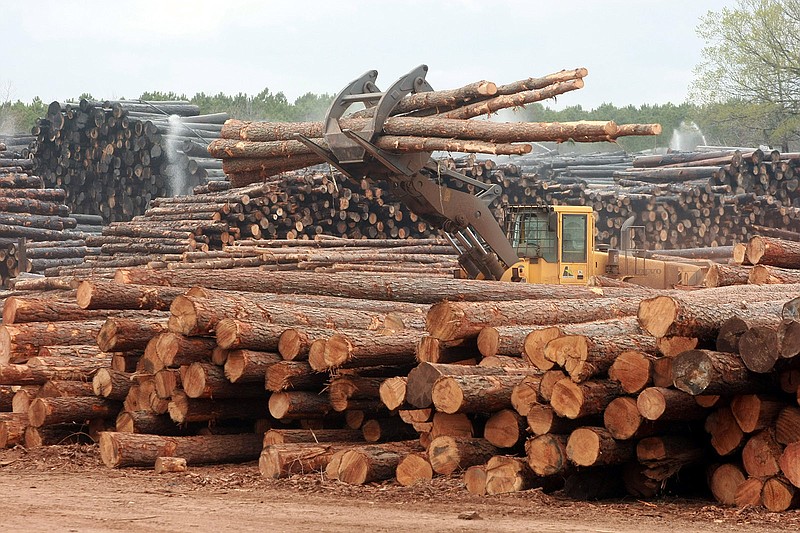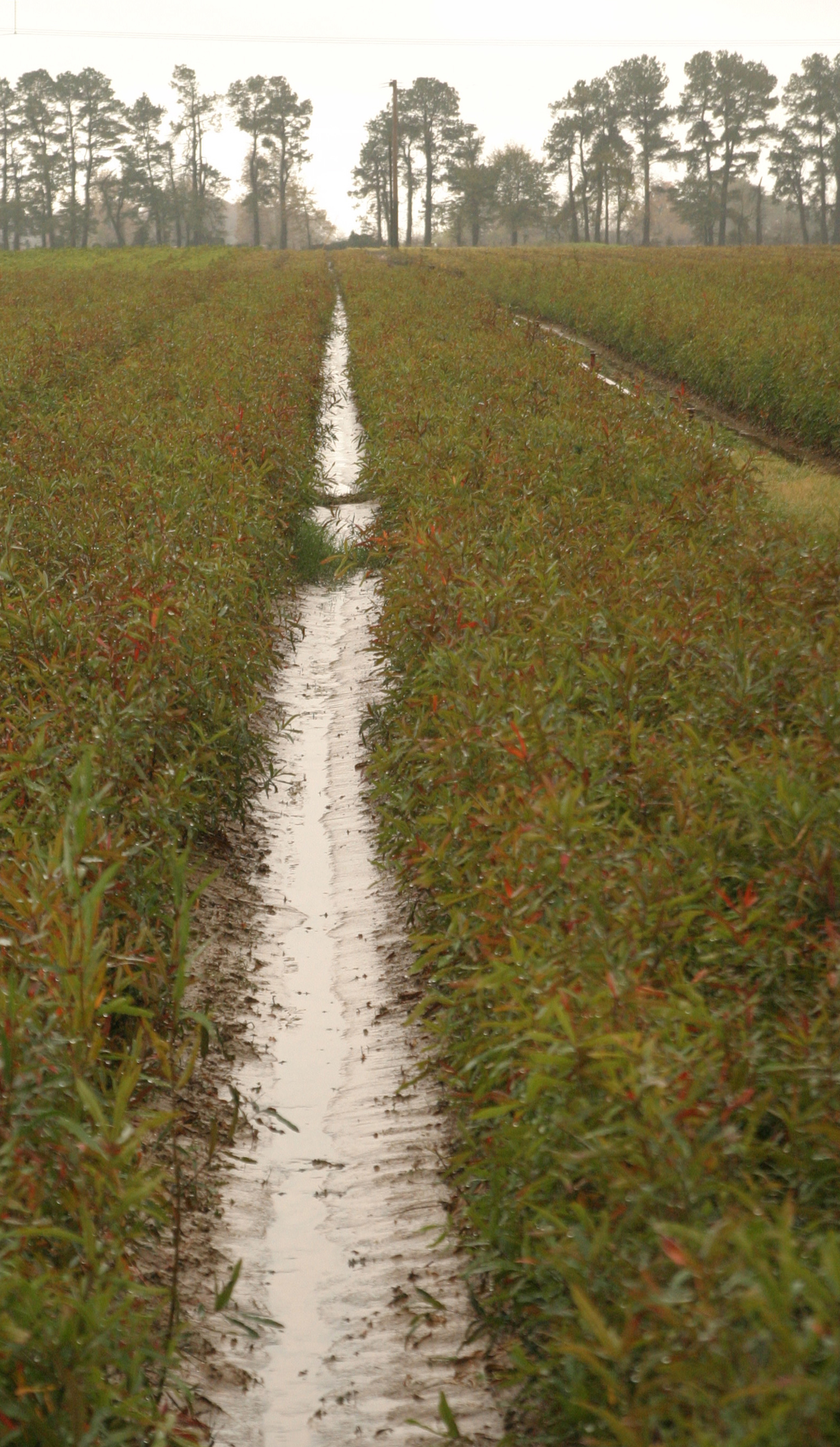We pull into the parking lot of the giant Domtar Corp. facility at Ashdown, and I breathe in that familiar paper mill smell.
It's familiar because I was raised in south Arkansas. When I played high school football at Arkadelphia in the 1970s, several conference opponents (Camden, Camden Fairview, Crossett and Ashdown) were in paper mill towns. We joked that it served as a home-field advantage for those teams since their players breathed the fumes on a daily basis and were more accustomed to the smell.
I'm with Max Braswell, who heads the Arkansas Forestry Association and once worked at this mill.
Ashdown, 19 miles north of Texarkana in the southwest corner of the state, was a timber town long before Nekoosa built the mill in 1968. The mill was sold to Georgia-Pacific in 1991 and to Domtar in 2001. Domtar is based at Fort Mill, S.C.
Ashdown was first known as Turkey Flats, then Keller, and finally Ashdown when it was incorporated in June 1892.
"It was named by Judge Lawrence Alexander Byrne, who owned sawmills in the area and who reportedly stated after a fire at his Keller mill that though the mill had 'burned down to ashes,' he was going to found a town there," Martha Trusley writes for the Central Arkansas Library System's Encyclopedia of Arkansas. "The town began to develop quickly with the coming of the railroad. In 1895, the Arkansas & Choctaw Railroad from Ashdown to Arkinda in Little River County was built."
Later, the railroad that would become Kansas City Southern led to additional growth. Crews cleared virgin forests in the area and shipped logs out by rail. Development of Millwood Lake in the early 1960s by the U.S. Army Corps of Engineers gave boosters of a paper mill the confidence that there would always be enough water for such industrial prospects.
Ashdown is a prime example of how closely the economic fate of south Arkansas is tied to that of the timber industry.
Domtar sources logs from a 120-mile radius, and more than 500 trucks a day find their way to the mill. The company has longtime relationships with growers in Arkansas, Texas, Louisiana and Oklahoma in order to ensure a steady supply of fiber.
Domtar employees work directly with 55 landowners who own almost 72,000 acres of timber to ensure they provide what's known as certified fiber.
Doug Teale, who has worked at the Ashdown mill for more than two decades, is group manager for Four States Timberland Owners Association. The association has about 265 members who control 632,000 acres of timber.
"The world is going green, and our customers want green, sustainable products," Teale says. "The owners association helps us ensure that we're doing the right things. Our people who work out in the woods and our logging contractors understand the importance of certification. The standards are stringent and are re-evaluated every four or five years. Third-party auditors see to it that we're doing it correctly."
Last May, it was announced that Domtar was being acquired by Paper Excellence, a global manufacturer of pulp and specialty, printing, writing and packaging papers. The announcement said Domtar would continue to operate as a stand-alone business entity. Domtar stockholders approved the deal in July.
Good news for Arkansas came that same month when it was announced that Domtar would restart a paper machine at Ashdown in 2022, adding 185,000 tons of capacity to its operations. The restart cost the company $10 million.
"As the economy begins to recover from the pandemic, the demand for paper is also recovering," Rob Melton, a Domtar senior vice president, said at the time. "Our customers' business is steadily growing, and we want to support that growth."
Allan Bohn, general manager of the Ashdown mill, came to Arkansas from North Carolina three years ago. He's an industry veteran who is used to responding to changing markets.
"There were four paper machines here, including one of the largest in North America," he says. "We initially reduced paper production in response to a growing market for pulp. When we shut a paper machine down, we added a pulp drier. More than 70 percent of the pulp is shipped out of New Orleans and Houston to China. On the paper side, we're the market leader for office papers."
Bohn thinks the Ashdown mill has a bright future.
"This is a really good operation," he says. "It's perfectly positioned in the middle of a huge wood basin. This facility was built to take on big projects, and I can promise you that there are big projects in our future. We're able to pivot rapidly in Ashdown because of the quality of the people we have working here. We have multigenerational employees whose families have been involved with this mill since it opened in 1968. We're going to be around here for a long time."
The best thing south Arkansas has going for it is the amount of timber being grown.
"Net timber growth continues to exceed harvests by more than 18 million tons annually, which will keep fiber resource costs low for the near future," Nana Tian and Matthew Pelkki write for the Arkansas Center for Forest Business at the University of Arkansas at Monticello. "Expansion and interest in the forest resources of the state remain strong."
Hundreds of timber industry jobs were shed during the Great Recession earlier in this century in south Arkansas towns such as Crossett and Warren. Those jobs never came back.
If south Arkansas is to achieve its economic potential, new jobs in the wood products sector will have to be created during the next decade.
The region continues to trail most of the state in job growth. The three largest metropolitan areas in Arkansas--northwest Arkansas, central Arkansas and the Fort Smith metro--accounted for 80 percent of the state's 49,366 year-over-year job gains in November. Northwest Arkansas alone contributed 44.1 percent of those gains.
Unemployment rates were just 1.5 percent in northwest Arkansas, 1.7 percent in the Jonesboro metro, 2.1 percent in the Fort Smith metro and 2.3 percent in central Arkansas.
Though down considerably from the previous year, unemployment rates were higher in south Arkansas: 2.8 percent in the Hot Springs metro, 3.5 percent in the Pine Bluff metro, and 4.2 percent in the Texarkana metro.
As south Arkansas tries to add jobs in the timber industry, it can look to its past for inspiration. A century ago, the region was among the nation's leaders in innovation.
"In 1900, timber processing was fairly straightforward," George Balogh writes in a history of the industry. "Contractors or company employees extended company logging railroads into the woods as needed, selected a tree, trimmed its branches, cut it down, rough-sawed it into manageable log sections and skidded it out of the woods to the railhead using mule teams. They would then load logs onto company railroad cars.
"Once logs made it to the sawmill, they were sorted by size, cut into boards, planed, dried and seasoned before being shipped to lumber markets by rail. By the mid-1920s, owners of huge timber acreages in south Arkansas such as the Crossett-Watzek-Gates group and International Paper began to notice a new phenomenon. Timberlands cleared at the turn of the century had usable forests."
Southern forests were growing back far more quickly than forests in the Great Lakes region where a number of the timber barons in south Arkansas previously had worked.
"U.S. pioneers in scientific forest management had established the first college-level forestry schools in the 1890s and 1900s," Balogh writes. "Gifford Pinchot, a Yale University graduate, trained in forestry at the French Forest School. On his return to the United States, Pinchot began experimenting with continuous forest growth at the Biltmore Estate in Asheville, N.C., in 1892. He then further refined this process, known as sustained yield forestry.
"In 1898, Cornell University offered a degree program in scientific forestry, and Pinchot was instrumental in launching a master's degree program in practical forestry at the Yale School of Forestry in 1900. Professionals from those programs began to view the pine forests as a crop and to communicate their message to forest owners across the South."
Cap Gates, manager of the Crossett Lumber Co., contacted Yale professor H.H. Chapman in 1926. Gates wanted to learn about sustainable forestry. Chapman, who had been conducting camps in northern Louisiana for Yale forestry students, told Gates to hire a professional forester.
"Gates hired W.K. Williams and began a tradition of professional forest management at Crossett," Balogh writes. "Arkansas visionaries such as L.K. Pomeroy, E.P. Connor, A.W. 'Wack' Wackerman and R.R. Reynolds joined national forestry figures in spreading the message of sustainability across the country. The management techniques used in Arkansas are still being applied to U.S. forests.
"Technical specialists and owners of Arkansas timberlands grappled with problems such as reducing waste, using smaller trees and producing diversified products. A long string of useful developments occurred between 1926 and 1980 to accomplish these objectives. Collectively these improvements are known as process orientation because they incorporated technology-based processes to add value to basic forest products."
International Paper opened a kraft paper mill--used for cardboard boxes and heavy-duty wrapping paper--at Camden in 1928. By 1968, the mill employed 2,100 people and turned out more than 500 tons of paper a day. IP closed the Camden mill in January 2001. The city's population has steadily declined since that time.
In a story for The Associated Press shortly after the closure, Melissa Nelson wrote: "For 73 years, the stacks at International Paper Co.'s mill belched gray, sour steam day and night over the pine woods of south Arkansas. On summer afternoons, the plumes sullied laundry hanging outside. On winter mornings, they guided deer hunters downwind of their quarry. In any season, townspeople knew the answer to the question 'paper or plastic?'
"But IP closed the paper-bag plant in January, leaving 580 workers without a way to support families long dependent on company paychecks. The employee union urged IP to sell to another papermaker, but the company refused to put it into a competitor's hands while the market is down."
By 1960 in Crossett, there was a kraft paper mill, a food board plant that made milk cartons and frozen-food packaging materials, and a flake board plant that made sheets of plywood-like boards. There also was a company that produced commercially useful chemicals from wood waste.
In 1963, Crossett Lumber Co. successor Georgia-Pacific opened a first-of-its-kind plywood plant in Fordyce. Layoffs would later hit Crossett and Fordyce hard. In September 2011, for example, Georgia-Pacific announced the layoff of 700 workers in Crossett.
"The layoff of 36 employees of the Arkansas Forestry Commission in late 2011 added to the image of a depressed industry," Balogh writes. "In time, recovery of the housing market improved the outlook of the wood products industry. It's uncertain whether that industry will return to its former prominent position as a producer of housing materials, shift to other ways of marketing the natural timber resources or assume a smaller role in the state's economy. The impact on the people and communities that rely on the industry also remains uncertain."
At a time when the economy is hitting on all cylinders in much of Arkansas, that uncertainty persists in the pine forests of the Gulf Coastal Plain.

